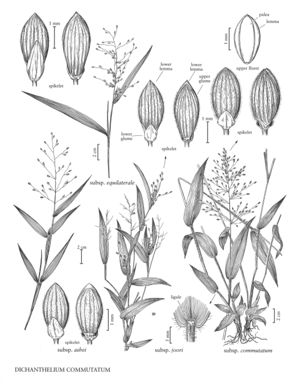Dichanthelium commutatum subsp. equilaterale
Treatment appears in FNA Volume 25. Treatment on page 414.
Plants from loose caudices. Culms stiffly erect, glabrous. Basal blades large, usually 8-14 cm long, 7-22 mm wide. Cauline blades 5-14 mm wide, about 10 times longer than wide, linear, thin, firm, spreading. Spikelets 3-3.2 mm; lower glumes 1.6-1.8 mm, about 1/2 as long as the spikelets.
Discussion
Dichanthelium commutatum subsp. equilaterale grows in sandy pine and oak woodlands. Its range extends to southeastern Mexico and Nicaragua.
Selected References
None.
Lower Taxa
None.
No values specified."usually distinctly longer and narrower" is not a number."decumbent" is not a number.
... more about "Dichanthelium commutatum subsp. equilaterale"
absent +
common +
absent +
bulliform +
absent +
membranous +
absent +
absent +
arising +
single +
large +
winter +
well-differentiated +
cordate-clasping +
asymmetrical +
hard +
thick +
distinct +
sprawling +
adaxial +
rebranching +
flexuous +
sprawling +
erect;erect +
absent +
sterile +
spikelike +
absent +
sterile +
not developed +
absent +
spreading +
longer +
longer +
12 cm120 mm <br />0.12 m <br /> (?) +
rebranching +
fascicles +
purplish +
not dense +
annual +
climbing +
floating +
herbaceous +
erect +
axillary +
glabrous +
woody +
narrow +
1/2 +
waisted +
large +
hard +
capillary +
germination +
adjacent +
sometimes longer +
well-developed +
absent +
reduced +
bisexual +
absent +
gaping +
shorter +
shorter or longer +
subtending +
unequal +
membranous +
equal +
papillose-based +
absent +
lacking +
uncinate +
punctate +
Present +
axillary +
elongated +
absent +
distichous +
hyaline +
coriaceous +
true +
absent +
0.3 cm3 mm <br />0.003 m <br /> (?) +
membranous +
free +
absent +
inconspicuous +
glabrous +
cuneate +
fleshy +
staminate +
sterile +
reduced +
1-5-veined +
absent +
thin +
separated +
hyaline +
involute +
papillose-based +
absent +
absent +
glabrous +
keeled +
sprawling +
subterranean +
erect +
exserted +
absent +
separating +
thin +
membranous +
developing +
exserted +
chasmogamous +
evident +
knotty +
smaller +
cleistogamous +
small +
higher +
included +
small +
open +
not overlapping +
not viscid +
closed +
complex +
bisexual +
unisexual +
sessile +
length +
attached +
absent +
pubescent +
ellipsoid +
varying +
simple +
convex +
Dichanthelium commutatum subsp. equilaterale +
Dichanthelium commutatum +
subspecies +
hyaline +
membranous +
sessile +
bisexual +
umbonate +
plump +
5-11-veined +
not saccate +
slightly shorter +
absent +
subequal +
equaling +
glabrous +
shiny +
chartaceous-indurate +
slightly shorter +
equaling +
absent +
rhizomatous +
perennial +
herbaceous +
various +
thick +
